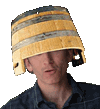DraQ
Arcane
So I've been thinking about damage scaling with strength (melee, bows), or speed or some attributes in general and came to a conclusion it doesn't really make sense.
Imagine you're stabbing someone with a dagger. "Damage" you deal will increase with more strength or speed but ony to a point. If you bury weapon up to the hilt in someone's body, then putting more strength won't result in extra damage.
The extra damage is not really straight damage anyway, just penetration. First, you don't deal any, then if you break the armour your damage increases only until full penetration is achieved. Even the penetration itself doesn't increase endlessly with increasing strength - a weapon may just be incapable of penetrating armour and putting in more strength will simply break it - relative durability or hardness should be a factor.
The max damage, measured with tissue disruption, done with thrusting weapon also depends on the target's bulk. If penetration of armour and body is full, then the damage dealt is either weapon's damage cap or creature's/bodypart's damage cap, whichever is lowest. Weapon's damage cap would correspond to it's length times base damage multiplier (corresponding to weapons width), while creature's/bodypart's damage cap would correspond to the distance weapon can travel inside before going out on the other side.
Depending on details of the system the cap may apply to raw damage that can be multiplied by crit hit multipliers or critical hits may depend on mechanics different from just damage (like hitting particular organs, % kill chance or whatever).
Now, thrusting weapons aren't the only ones in existence. With slashing attacks damage should scale higher (because it only caps when part of the body is severed and max damage generally increases with square of weapon's length), but the mechanism is the same.
Of course, damage cap shouldn't be the only factor in dealing damage, different weapons and attacks would also have different penetration modifiers - for example slashing wouldn't penetrate as well as stabbing.
From this perspective blunt weapons would be a really wide and not very sharp slashing weapons (lots of damage, abysmal penetration) but that would be off. Blunt weapons have ability to bypass armour by transferring kinetic energy to the target rather than disrupting it physically. But since you can bludgeon someone with a pommel or break their bones with a zweihander even if you can't cut through the mail, there should be no distinction here and all weapons should also deal damage via energy transfer term. It should depend on weapon's mass but also how much of a swing got soaked by armour and body (part soaked by armour would get partially dissipated) - for example imagine you're slicing someone with a heavy, but absurdly thin and sharp blade - despite high mass you wouldn't really deal any significant amount of blunt force trauma as it would just pass through without slowing.
Obviously, it would be easier to implement something like this starting from a physical engine, but the point I was trying to make is that scaling damage with attribute should be heavily capped and that most of it should be handled by scaling armour piercing modifier instead.

Imagine you're stabbing someone with a dagger. "Damage" you deal will increase with more strength or speed but ony to a point. If you bury weapon up to the hilt in someone's body, then putting more strength won't result in extra damage.
The extra damage is not really straight damage anyway, just penetration. First, you don't deal any, then if you break the armour your damage increases only until full penetration is achieved. Even the penetration itself doesn't increase endlessly with increasing strength - a weapon may just be incapable of penetrating armour and putting in more strength will simply break it - relative durability or hardness should be a factor.
The max damage, measured with tissue disruption, done with thrusting weapon also depends on the target's bulk. If penetration of armour and body is full, then the damage dealt is either weapon's damage cap or creature's/bodypart's damage cap, whichever is lowest. Weapon's damage cap would correspond to it's length times base damage multiplier (corresponding to weapons width), while creature's/bodypart's damage cap would correspond to the distance weapon can travel inside before going out on the other side.
Depending on details of the system the cap may apply to raw damage that can be multiplied by crit hit multipliers or critical hits may depend on mechanics different from just damage (like hitting particular organs, % kill chance or whatever).
Now, thrusting weapons aren't the only ones in existence. With slashing attacks damage should scale higher (because it only caps when part of the body is severed and max damage generally increases with square of weapon's length), but the mechanism is the same.
Of course, damage cap shouldn't be the only factor in dealing damage, different weapons and attacks would also have different penetration modifiers - for example slashing wouldn't penetrate as well as stabbing.
From this perspective blunt weapons would be a really wide and not very sharp slashing weapons (lots of damage, abysmal penetration) but that would be off. Blunt weapons have ability to bypass armour by transferring kinetic energy to the target rather than disrupting it physically. But since you can bludgeon someone with a pommel or break their bones with a zweihander even if you can't cut through the mail, there should be no distinction here and all weapons should also deal damage via energy transfer term. It should depend on weapon's mass but also how much of a swing got soaked by armour and body (part soaked by armour would get partially dissipated) - for example imagine you're slicing someone with a heavy, but absurdly thin and sharp blade - despite high mass you wouldn't really deal any significant amount of blunt force trauma as it would just pass through without slowing.
Obviously, it would be easier to implement something like this starting from a physical engine, but the point I was trying to make is that scaling damage with attribute should be heavily capped and that most of it should be handled by scaling armour piercing modifier instead.








![Glory to Codexia! [2012] Codex 2012](/forums/smiles/campaign_tags/campaign_slushfund2012.png)










